Deepak Joshi
Lightweight Transformer-Driven Segmentation of Hotspots and Snail Trails in Solar PV Thermal Imagery
Jul 28, 2025Abstract:Accurate detection of defects such as hotspots and snail trails in photovoltaic modules is essential for maintaining energy efficiency and system reliablility. This work presents a supervised deep learning framework for segmenting thermal infrared images of PV panels, using a dataset of 277 aerial thermographic images captured by zenmuse XT infrared camera mounted on a DJI Matrice 100 drone. The preprocessing pipeline includes image resizing, CLAHE based contrast enhancement, denoising, and normalisation. A lightweight semantic segmentation model based on SegFormer is developed, featuring a customised Transformwer encoder and streamlined decoder, and fine-tuned on annotated images with manually labeled defect regions. To evaluate performance, we benchmark our model against U-Net, DeepLabV3, PSPNet, and Mask2Former using consistent preprocessing and augmentation. Evaluation metrices includes per-class Dice score, F1-score, Cohen's kappa, mean IoU, and pixel accuracy. The SegFormer-based model outperforms baselines in accuracy and efficiency, particularly for segmenting small and irregular defects. Its lightweight design real-time deployment on edge devices and seamless integration with drone-based systems for automated inspection of large-scale solar farms.
Handwriting-based Automated Assessment and Grading of Degree of Handedness: A Pilot Study
Dec 02, 2024

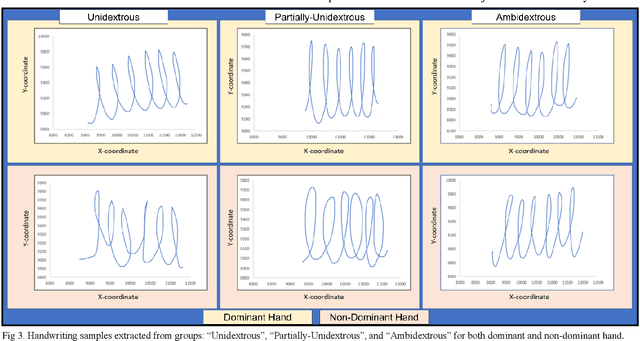
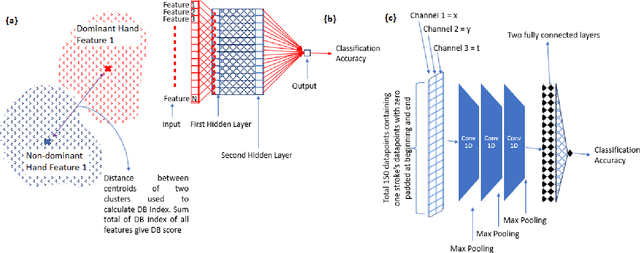
Abstract:Hand preference and degree of handedness (DoH) are two different aspects of human behavior which are often confused to be one. DoH is a person's inherent capability of the brain; affected by nature and nurture. In this study, we used dominant and non-dominant handwriting traits to assess DoH for the first time, on 43 subjects of three categories- Unidextrous, Partially Unidextrous, and Ambidextrous. Features extracted from the segmented handwriting signals called strokes were used for DoH quantification. Davies Bouldin Index, Multilayer perceptron, and Convolutional Neural Network (CNN) were used for automated grading of DoH. The outcomes of these methods were compared with the widely used DoH assessment questionnaires from Edinburgh Inventory (EI). The CNN based automated grading outperformed other computational methods with an average classification accuracy of 95.06% under stratified 10-fold cross-validation. The leave-one-subject-out strategy on this CNN resulted in a test individual's DoH score which was converted into a 4-point score. Around 90% of the obtained scores from all the implemented computational methods were found to be in accordance with the EI scores under 95% confidence interval. Automated grading of degree of handedness using handwriting signals can provide more resolution to the Edinburgh Inventory scores. This could be used in multiple applications concerned with neuroscience, rehabilitation, physiology, psychometry, behavioral sciences, and forensics.
Direction of slip modulates the perception of slip distance and slip speed
Mar 08, 2024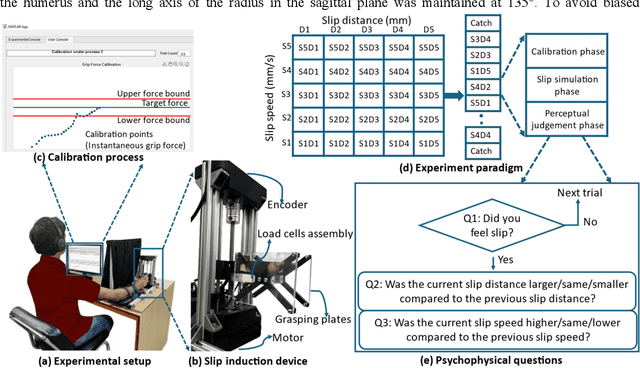



Abstract:Purpose: The purpose of this study was to investigate the psychophysical understanding of the slip stimulus. We emphasized that the perception of slip and its characteristics, such as slip distance and slip speed depend on the interaction between slip direction, slip distance as well as slip speed. Methods: We developed a novel slip induction device to simulate the artificial sense of slip. We conducted a psychophysical experiment on eight healthy subjects. The experiment was designed to evaluate the effect of slip direction on slip perception as well as on the perception of slip distance and slip speed. A series of psychophysical questions were asked at the end of the slip stimulation to record the subjective responses of the participants. The average success rate (%) was used to quantify the subject responses. Results: We demonstrated that the perception of slip is independent of slip direction however, perception of slip distance and slip speed are significantly modulated by slip direction. We also observed that a significant interaction exists between slip distance and slip speed in the upward slip direction. It was also observed that the average success rate was significantly different for various combinations of slip distance and slip speed in the upward slip direction. Conclusions: Our study clearly establishes a significant interaction between the slip direction, slip distance, and slip speed for psychophysical understanding of the perception of slip distance and slip speed.
Unveiling Emotions from EEG: A GRU-Based Approach
Jul 20, 2023



Abstract:One of the most important study areas in affective computing is emotion identification using EEG data. In this study, the Gated Recurrent Unit (GRU) algorithm, which is a type of Recurrent Neural Networks (RNNs), is tested to see if it can use EEG signals to predict emotional states. Our publicly accessible dataset consists of resting neutral data as well as EEG recordings from people who were exposed to stimuli evoking happy, neutral, and negative emotions. For the best feature extraction, we pre-process the EEG data using artifact removal, bandpass filters, and normalization methods. With 100% accuracy on the validation set, our model produced outstanding results by utilizing the GRU's capacity to capture temporal dependencies. When compared to other machine learning techniques, our GRU model's Extreme Gradient Boosting Classifier had the highest accuracy. Our investigation of the confusion matrix revealed insightful information about the performance of the model, enabling precise emotion classification. This study emphasizes the potential of deep learning models like GRUs for emotion recognition and advances in affective computing. Our findings open up new possibilities for interacting with computers and comprehending how emotions are expressed through brainwave activity.
Noise removal methods on ambulatory EEG: A Survey
Jul 17, 2023Abstract:Over many decades, research is being attempted for the removal of noise in the ambulatory EEG. In this respect, an enormous number of research papers is published for identification of noise removal, It is difficult to present a detailed review of all these literature. Therefore, in this paper, an attempt has been made to review the detection and removal of an noise. More than 100 research papers have been discussed to discern the techniques for detecting and removal the ambulatory EEG. Further, the literature survey shows that the pattern recognition required to detect ambulatory method, eye open and close, varies with different conditions of EEG datasets. This is mainly due to the fact that EEG detected under different conditions has different characteristics. This is, in turn, necessitates the identification of pattern recognition technique to effectively distinguish EEG noise data from a various condition of EEG data.
A Robust and Accurate Deep Learning based Pattern Recognition Framework for Upper Limb Prosthesis using sEMG
Jun 11, 2021

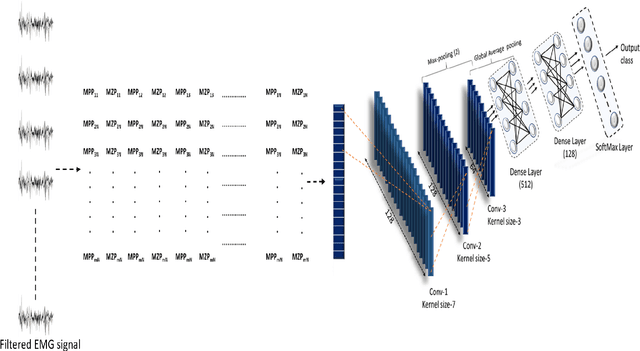

Abstract:In EMG based pattern recognition (EMG-PR), deep learning-based techniques have become more prominent for their self-regulating capability to extract discriminant features from large data-sets. Moreover, the performance of traditional machine learning-based methods show limitation to categorize over a certain number of classes and degrades over a period of time. In this paper, an accurate, robust, and fast convolutional neural network-based framework for EMG pattern identification is presented. To assess the performance of the proposed system, five publicly available and benchmark data-sets of upper limb activities were used. This data-set contains 49 to 52 upper limb motions (NinaPro DB1, NinaPro DB2, and NinaPro DB3), Data with force variation, and data with arm position variation for intact and amputated subjects. The classification accuracies of 91.11% (53 classes), 89.45% (49 classes), 81.67% (49 classes of amputees), 95.67% (6 classes with force variation), and 99.11% (8 classes with arm position variation) have been observed during the testing and validation. The performance of the proposed system is compared with the state of art techniques in the literature. The findings demonstrate that classification accuracy and time complexity have improved significantly. Keras, TensorFlow's high-level API for constructing deep learning models, was used for signal pre-processing and deep-learning-based algorithms. The suggested method was run on an Intel 3.5GHz Core i7, 7th Gen CPU with 8GB DDR4 RAM.
Gender specific and Age dependent classification model for improved diagnosis in Parkinson's disease
Apr 26, 2019



Abstract:Accurate diagnosis is crucial for preventing the progression of Parkinson's, as well as improving the quality of life with individuals with Parkinson's disease. In this paper, we develop a gender specific and age dependent classification method to diagnose the Parkinson's disease using the handwriting based measurements. The gender specific and age dependent classifier was observed significantly outperforming the generalized classifier. An improved accuracy of 83.75% (SD=1.63) with the female specific classifier, and 79.55% (SD=1.58) with the old age dependent classifier was observed in comparison to 75.76% (SD=1.17) accuracy with the generalized classifier. Finally, combining the age and gender information proved to be encouraging in classification. We performed a rigorous analysis to observe the dominance of gender specific and age dependent features for Parkinson's detection and ranked them using the support vector machine(SVM) ranking method. Distinct set of features were observed to be dominating for higher classification accuracy in different category of classification.
Illusory Sense of Human Touch from a Warm and Soft Artificial Hand
Feb 27, 2015
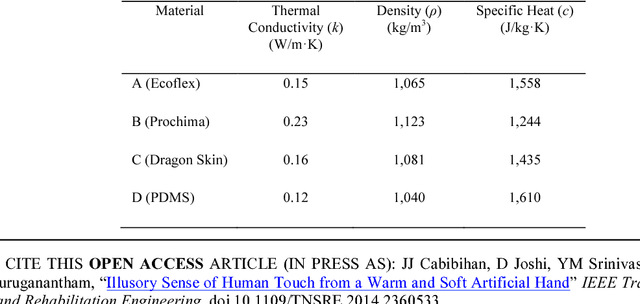
Abstract:To touch and be touched are vital to human development, well being, and relationships. However, to those who have lost their arms and hands due to accident or war, touching becomes a serious concern that often leads to psychosocial issues and social stigma. In this paper, we demonstrate that the touch from a warm and soft rubber hand can be perceived by another person as if the touch were coming from a human hand. We describe a three step process toward this goal. First, we made participants select artificial skin samples according to their preferred warmth and softness characteristics. At room temperature, the preferred warmth was found to be 28.4 deg C at the skin surface of a soft silicone rubber material that has a Shore durometer value of 30 at the OO scale. Second, we developed a process to create a rubber hand replica of a human hand. To compare the skin softness of a human hand and artificial hands, a robotic indenter was employed to produce a softness map by recording the displacement data when constant indentation force of 1 N was applied to 780 data points on the palmar side of the hand. Results showed that an artificial hand with skeletal structure is as soft as a human hand. Lastly, the participants arms were touched with human and artificial hands, but they were prevented to see the hand that touched them. Receiver operating characteristic curve analysis suggests that a warm and soft artificial hand can create an illusion that the touch is from a human hand. These findings open the possibilities for prosthetic and robotic hands that are lifelike and are more socially acceptable.
 Add to Chrome
Add to Chrome Add to Firefox
Add to Firefox Add to Edge
Add to Edge